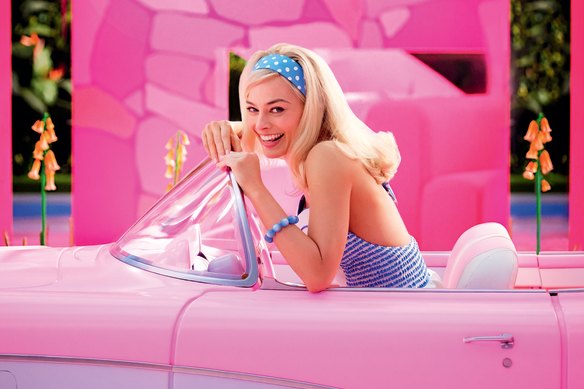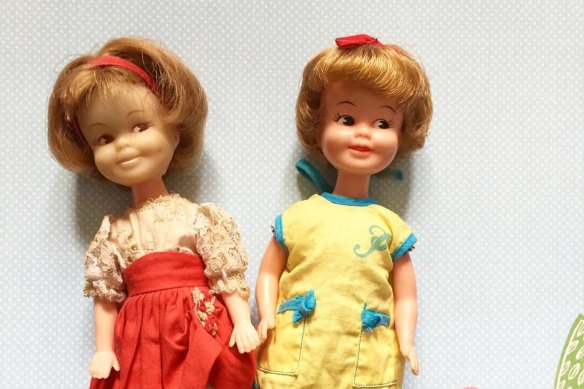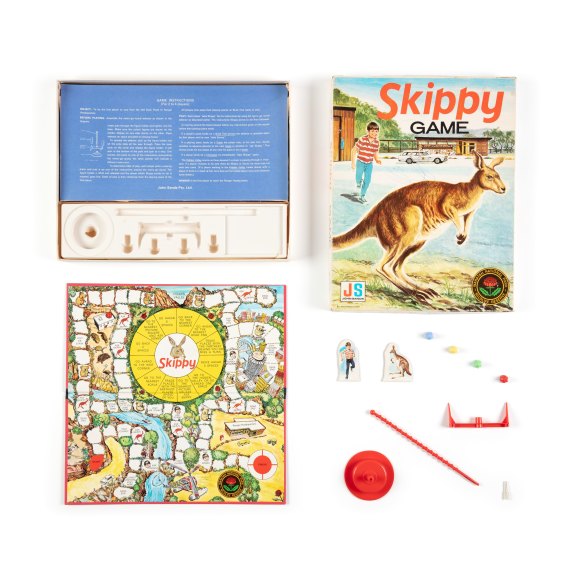Save articles for later
Add articles to your saved list and come back to them any time.
I notice they’ve made a film based on Barbie, the American children’s doll, so why not a movie based on her Antipodean equivalent, Little Tuppence? In the era of globalisation, there’s no longer much room for local dolls, board games or toys. But in the ’60s and ’70s, there was always room for a home version of an imported hit.
Barbie was introduced to Australia in April 1964, quickly followed by a UK contender called Sindy and then – in 1965 – by Little Tuppence, made by the New Zealand company Lincoln International. A review of all three dolls in the magazine The Bulletin in September 1965 declares Barbie the best as it “teaches little girls to be fashion conscious”. The article does, though, cheer on Little Tuppence for being cheaper, although “the range of clothes is not as great”.
Margot Robbie as Barbie.Credit: Courtesy of Warner Bros. Pictures
All the same, Little Tuppence would make for a great movie, especially if you included her sidekick Posing Penny, who arrived in a red polka dot bikini but was said to be always keen to try a new outfit. As the marketing put it: “Little Tuppence and Posing Penny are the best of friends. They share everything – even their clothes.”
The filmmakers could also work in the scene in which dancers dressed as Little Tuppence and Posing Penny were featured alongside Johnny O’Keefe in the TV show Sing, Sing, Sing. It was an appearance which helped generate sales of $400,000 in the doll’s first year, double the company’s expectations.
If international dolls such as Barbie had local equivalents, so did many of the imported board games. One still available is Squatter, a version of Monopoly in which you buy up sheep stations and see how thoroughly you can overstock them. The whole thing is propaganda for the National Party as it demonstrates the difficulties faced by farmers.
Little Tuppence and Penny.Credit: Instagram/the_dolly_emporium
Every “chance” card seems to involve wild dogs killing many sheep, your bore drying up or the election of the Albanese government. OK, I made the last one up, but the other two are true. Also true: “Out of control weeds”, “Out of control insects” and “Injured in a tractor accident – miss two throws”. Play five rounds and you’ll be voting for a return of the superphosphate bounty.
Other locally designed games have not managed to last the distance. An example: TAA’s 1969 Travel Around Australia game? The box describes the aim of the game: “Players take a quest to travel around Australia to buy up the landing rights to its airports.”
It all sounds like a training course for Macquarie Bank executives. Once you’ve purchased an airport, players “charge landing and other fees on their opponents who land there”, the game ending when “all players except one are bankrupt, making the only one with cash the winner”.
Who designed this game? Karl Marx?
An alternative might be Digit Dick’s Walkabout on the Great Barrier Reef. A 1950s game, based on the book by Leslie Rees, it details the adventures of Digit Dick, a “little boy only as big as his mother’s big toe”, who smuggles himself on holiday with his parents in his father’s coat pocket. The character’s rather louche name may be a barrier to its reintroduction, I can’t be sure.
The Skippy board game.Credit: Museum of Applied Arts and Sciences
Or there’s the Skippy Game of 1970, in which players endeavour to “Be the first to get to the Ranger Headquarters!” with the occasional leg-up of a dice throw in which you “Go straight to the Nearest Koala”.
A twirling merry-go-around gives players the regular chance to “Ask Skippy” for directions which, if the TV show is any guide, would involve Skippy going “tsk, tsk, tsk”, while the players say, “What’s that, Skip? Go five squares ahead and then turn right at the river? Then we’ll see the smugglers hiding in the cave? Is that right, Skip?”
Perhaps more challenging to contemporary sensibilities is the 1986 John Sands board game The Voyage of the First Fleeters, in which the aim is to “be the first to successfully transport your ship of convicts from Portsmouth, England and set up a colony in Sydney, Australia”.
It’s unclear at which point you mistakenly declare the country as terra nullius. Who knows? Maybe the game comes with a free blindfold.
If brutal colonisation is no longer deemed a proper subject for a board game, at least cricket can still be celebrated. One of the most popular board games in the 1970s was Test Match Cricket, which featured tiny plastic players who, via a series of flimsy levers, were made to bat and bowl in a way that was totally unconvincing. You had to use your imagination. A lot of imagination.
Maybe that was true too of Little Tuppence and Posing Penny. According to advertising of the time, the dolls would “let your child discover a new joy of living”, with an outfit “for every occasion”.
Well, for at least five occasions, these comprising “skating, riding, skiing, flying and nursing”, although there was a Bride of the Year Little Tuppence issued in 1966 with a white dress and bouquet of plastic flowers.
That marriage, with Posing Penny as bridesmaid, will be a sure-fire scene in the forthcoming Little Tuppence movie. Better still, Margot Robbie will be able to use her own accent.
To read more from Spectrum, visit our page here.
Most Viewed in Culture
From our partners
Source: Read Full Article






